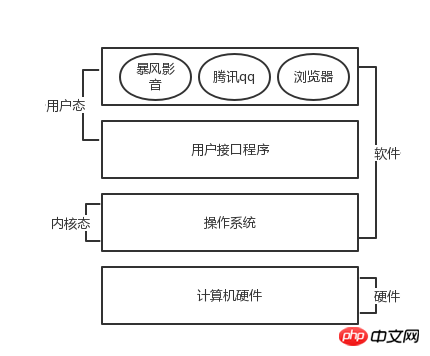Programmers cannot understand all the details of hardware operations, because managing these hardware and optimizing their use is a very tedious task. This tedious task The work is done by the operating system. With it, programmers are freed from these tedious tasks and only need to consider writing their own application software. The application software directly uses the functions provided by the operating system to indirectly use the hardware.

Operation The system is located between computer hardware and application software, and is essentially a software. The operating system consists of two parts: the operating system's kernel (running in the kernel state, managing hardware resources) and system calls (running in the user state, providing system callsinterfacefor applications written by application programmers)Groupinginto
hides the ugly hardware call interface and provides application programmers with more information about calling hardware resources. Well, a simpler and clearermodel(system call interface). Once application programmers have these interfaces, they no longer need to consider the details of operating the hardware and can concentrate on developing their own applications
Organize (multiplex) applications' competing requests for hardware resources
The first generation (1940~1955) vacuum tubes and punched cards
Features: There is no concept of operating system, all programming is written in pure machine language
Working process: The programmer makes an appointment on the computer timetable on the wall for a period of time. Then the programmer takes his plug-in board to the computer room and connects his plug-in board to the computer. , during these few hours, he had exclusive access to the entire computer's resources, and the next group of people had to wait (more than 20,000 vacuum tubes were often burned out). Later, punched cards appeared, and programs could be written on card, and then read it into the machine without using a plug-in board
Advantages: Programmers have exclusive access to the entire resource during the applied time period, and can adjust their own programs in real time, and bugs can be dealt with in a timely manner
Disadvantages: Waste of resources
Second generation (1955~1965) transistor and batch processing system
Features: Mainframes run by professional operators have the concept of an operating system: it is a system that combines human power and computers and requires human participation. With programming language:FORTAN language or assembly language, write it on paper, then punch it into cards, take the card box to the input city, and hand it to the operator to wait for the output interface
work process


Problems with the first generation of computers:Human-computer interactionMultiple
How the second generation solves the problems of the first generation: put a bunch of People's input is accumulated into a large wave of input, and then the order is extreme, and then a group of people's output is accumulated into a large wave of output
Advantages: Batch processing, saving time
Disadvantages: The entire process requires human participation, the calculation process is still serial, and the programmer has exclusive access to it for a period of time. The process of waiting for the results and redebuggingrequires other programs in the same batch to be completed. Can
The third generation (1965~1980) integrated circuit chips and multi-programming
How to solve the problems of the second generation computer 1 :
After the card is taken to the computer room, thejobcan be quickly read from the card to the disk, so at any time when a job ends, the operating system can read a job from the tape out, into the vacated memory area to run, this technology is called simultaneous external device online operation: SPOOLING, this technology is used for output at the same time. When this technology is adopted, the IBM1401 machine is no longer needed, and the tapes do not need to be moved around (the two villains in the middle are no longer needed)
How to solve the second generation Computer Problem 2:
The operating system of the third generation computer widely uses a key technology that the operating system of the second generation computer does not have: multi-channel technology
Multi-channel in multi-channel technology refers to multiple programs. The implementation of multi-channel technology is to solve the orderly scheduling problem of multiple programs competing or sharing the same resource (such as CPU). The solution is multi-channel Multiplexing, multiplexing is divided into time multiplexing and spatial multiplexing
The biggest problem with spatial multiplexing is: the direct memory of the program must be divided, and this division is implemented at the hardware level , controlled by the operating system. If the memories are not divided from each other, one program can access the memory of another program
The operating system of the third generation computer is still batch processing. Many programmers miss the exclusive computer of the first generation and can debug themselves on the fly. program of. In order to satisfy programmers who can get responses quickly, a time-sharing operating system appeared.
How to solve the problem of second-generation computers 3:
Time-sharing operating system
Multiple online terminals +Multi-channel technology
After the third generation of computers widely adopted necessary protection hardware (memories between programs are isolated from each other), time-sharing systems became popular
Later, a person participated in MULTICS Bell Labs computer scientist Ken Thompson developed a simple, single-user version of MULTICS, which became the UNIX system. Based on it, many other Unix versions have been derived. In order to enable programs to run on any version of Unix, IEEE proposed a Unix standard, namely posix (Portable Operating System Interface)Later, in 1987, a small clone of UNIX, minix, appeared for educational use. Finnish student Linus Torvalds wrote
Linuxbased on it. The fourth generation computer (1980~present): Personal Computer
slightly
Two major functions of the operating system:Implementation method:
Reuse in time, multiplex in space
The above is the detailed content of windows operating system. For more information, please follow other related articles on the PHP Chinese website!




